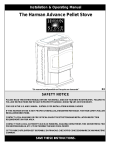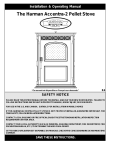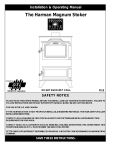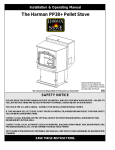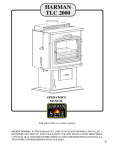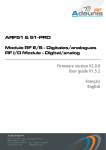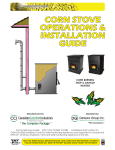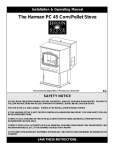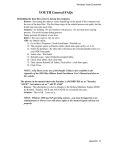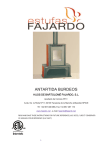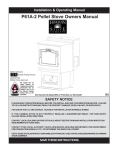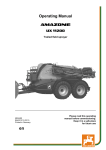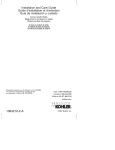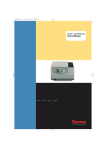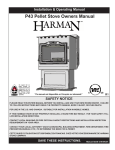Download Harman Stove Company The Harman Accentra Pellet Insert User's Manual
Transcript
Installation & Operating Manual The Harman Accentra Pellet Insert “Ce manuel est disponible en Français sur demande” R3 SAFETY NOTICE PLEASE READ THIS ENTIRE MANUAL BEFORE YOU INSTALL AND USE YOUR NEW ROOM HEATER. FAILURE TO FOLLOW INSTRUCTIONS MAY RESULT IN PROPERTY DAMAGE, BODILY INJURY, OR EVEN DEATH. FOR USE IN THE U.S. AND CANADA. SUITABLE FOR INSTALLATION IN MOBILE HOMES IF THIS HARMAN ACCENTRA PELLET INSERT IS NOT PROPERLY INSTALLED, A HOUSEFIRE MAY RESULT. FOR YOUR SAFETY, FOLLOW INSTALLATION DIRECTIONS. CONTACT LOCAL BUILDING OR FIRE OFFICIALS ABOUT RESTRICTIONS AND INSTALLATION INSPECTION REQUIREMENTS IN YOUR AREA. CONTACT YOUR LOCAL AUTHORITY (SUCH AS MUNICIPAL BUILDING DEPARTMENT, FIRE DEPARTMENT, FIRE PREVENTION BUREAU, ETC.) TO DETERMINE THE NEED FOR A PERMIT. CETTE GUIDE D'UTILISATION EST DISPONIBLE EN FRANCAIS. CHEZ VOTRE CONCESSIONNAIRE DE HARMAN STOVE COMPANY. SAVE THESE INSTRUCTIONS. Introduction 3 The Accentra Insert will give you more heat, better temperature control and a level of convenience you won’t find in any other pellet insert. The Accentra Insert’s many outstanding features make it the best value pellet insert on the market today. The Accentra’s versatile design lets you convert a heat wasting fireplace into an efficient heating source. The Accentra Insert could also be a fireplace hearth for your home that doesn’t require a chimney. A special zero clearance fireplace kit converts the Accentra insert into a fireplace that can be placed in virtually any corner or against any wall of your home. You can choose from a variety of mantels and facings that complement your homes décor. The Accentra’s on-board microprocessor constantly senses room temperature and automatically makes adjustments in the feed rate and air supply so you get just the right amount of heat 24 hours a day. This remarkable technology lets you fill the hopper, set the desired temperature and walk away. The Accentra insert lights automatically, brings the room up to the exact temperature and will turn off if no heat is required. No other pellet insert offers such accurate and trouble free temperature control. The control technology gives you the widest heat output range of any insert on the market making it an ideal choice to take the chill off in the spring and fall and to heat your home during the coldest months of the winter. As with all Harman pellet stoves, maintenance is minimal and cleaning is easy. The Accentra Insert lets you burn close to a ton of pellets before ash removal is needed. And what is even better, the Harman Insert Track System lets you slide the insert out of the fireplace so that it can be cleaned or serviced without having to disconnect the venting system. This innovative design is only available on Harman pellet inserts and lets you reach key components for yearly cleaning. Plea se c opy y o u r serial number from the label on your stove to the box below. SERIAL NUMBER Table of Contents SAFETY NOTICE: IF THIS HARMAN STOVE IS NOT PROPERLY INSTALLED. A HOUSE FIRE MAY RESULT. FOR YOUR SAFETY, FOLLOW THE INSTALLATION DIRECTIONS CONTACT LOCAL BUILDING OR FIRE OFFICIALS ABOUT RESTRICTIONS AND INSTALLATION INSPECTION REQUIREMENTS IN YOUR AREA. Harman Stove Company 352 Mountain House Road Halifax, PA 17032 [email protected] Automatic Operation 4 Manual Operation 6 ESP Control 8 Assembly & Installation 9 Venting 21 Maintenance 28 Trouble-Shooting 33 Specifications 34 Wiring Diagram 35 Feeder Parts 36 Parts List 37 Warranty 38 Automatic Start Up 4 Starting First Fire Igniter Switch to"AUTO" (up position) Make sure the unit is plugged into a 120 VAC, 60 HZ electrical source. The power light should be the only light lit. See Note 7. 1" Fig. 1 Fig. 2 1. Fines are small pieces of broken pellets (sawdust). Fines do not flow easily and often build up on the hopper funnel bottom angles. These fines can be pushed into the feeder opening and then fill the hopper with pellets. As the system works, they will be burned. 2. The "TEST" cycle will operate the feeder motor for exactly one minute. Turning to "TEST" again and again may purge too much fuel into the burn pot causing excessive smoke on startup. 3. The firebox low pressure switch will not allow the auger motor or the igniter element to operate if the view door is open. 4. Adjust Feed Rate. If this is your first fire or you are trying different pellets, set the feed adjuster to #4, Fig. 1. This is a conservative number and will probably need to be increased. After you know a feed rate setting that works well, use that setting. Remember, if your feed rate is too high you may waste fuel. 5. This is usually a weekly maintence procedure. Cleaning the burn pot with the scraper with a small amount of new fuel in the bottom is not a problem. First, scrape the ashes on the front of the burn pot into the ash pan. Then scrape the holed surface downward into the burn pot. When the stove is ignited these scrapings will be pushed out by the feeder. 6. The ash pan can hold the ashes from approximately 1 ton of premium fuel. This means the ashes will only need to be emptied a few times a year. 7. Setting the feed adjuster # for maximum burn: With the unit burning in "AUTO", turn to "Stove Mode" and put the fan on "H". Set the Temperature Dial to #7. Allow the unit to burn for about 30 minutes and check ash on front of burn pot. Fig. 4. If the ash line is larger than 1", turn the feed adjuster from #4 to #5. Allow another 30 minutes of burn time and check again. If , at #6 setting, a 1" or less ash bed is not obtainable, it is not a problem. The 1" ash bed is only a maximum burn rate and at most normal settings the ash bed will be larger. 1. Turn Mode Selector to "OFF". 2. Fill hopper with pellets.1 3. Clean burn pot with scraper, if necessary.5 4. If starting after an empty hopper, turn Feed Adjuster to "TEST" (for one 60 second cycle).2 This will purge pellets into the auger tube and also allow you to check the motors for operation.NOTE: The auger motor will not operate with the view door or ash pan door open.3 5. Turn Feed Adjuster to #4.4 6. Flip the Igniter Switch up into the "AUTO" position. 7. Turn the Temperature Dial to desired room temperature. 8. Turn Mode Selector to Room Temperature or Stove Temperature. 9. Fill hopper with pellets and remove ashes as required.6 10. Store pellet fuel in a dry area away from all ignition sources and above all limits of the stove's clearance requirements to combustibles. Do not store the fuel were it interferes with the refueling of the stove or emptying of ashes. Do not store any ashes removed from the stove near the fuel or other combustible materials. WARNING BURNING GARBAGE, USE OF IMPROPER FUELS, FIRE STARTERS OR ALTERING THE STOVE FOR HIGHER HEAT OUTPUT MAY CAUSE DAMAGE TO THE STOVE AND COULD RESULT IN A HOUSE FIRE. USE ONLY APPROVED FUELS AND OPERATION GUIDELINES. WARNING NEVER USE GASOLINE, GASOLINE-TYPE LANTERN FUEL, KEROSENE, CHARCOAL LIGHTER FLUID, OR SIMILAR LIQUIDS TO START OR 'FRESHEN UP' A FIRE IN THIS HEATER. KEEP ALL SUCH LIQUIDS WELL AWAY FROM THE HEATER WHILE IN USE. Automatic Ignition/Operation 5 The Accentra Insert is more than just automatic ignition, it is also automatic temperature control. The automatic system will allow the fire size to be adjusted to match the heating needs and even put the fire out if necessary. If heat is needed after the fire is out, the Accentra Insert will automatically re-ignite and adjust the fire size to match the heating need. The totally automatic room sensor mode is recommended because of its efficiency. The unit can be switched between "AUTO" and "MANUAL" at any time during operation. Fig. 3 Room Temperature M ode: This setting will produce a room temperature of 70 degrees with the distribution blower at medium speed. Stove Temperature Mode This setting will produce medium heat with the distribution blower on "low". This setting will produce continuous maximum heat output with the distribution blower at full speed. Fig. 4 Igniter switch to "AUTO" Room Temperature Mode In "Room Temp Mode" heat output is controlled automatically by the Room Sensing Probe. When the Room Sensing Probe calls for heat, the stove will increase output. When the Room Sensing Probe is getting close to the set temperature, the stove will begin to level off output and keep the fire burning at just the right temperature to maintain that setting. High output is determined by the feed rate setting. This setting, generally on #4, can be increased if higher burn rates are necessary (Fig. 1). The unit's maximum burn rate should not create less than 1" of ash on the burn pot front edge(See Fig.2). Overfeeding is not a safety concern, but fuel may be wasted if unburned pellets fall into the ash pan. In "Room Temp Mode" a constant fuel consumption rate is sacrificed for exact room temperature. Therefore, as it gets colder more pellets will be burned automatically. The distribution blower speed will vary according to the position of the mode selector pointer, and fire size. Igniter switch to "AUTO" Stove Temperature Mode This allows for automatic ignition upon start-up only. The unit can then be set at any desired setting. The heat output and fuel consumption will remain constant regardless of room temperature (See Fig 4). The unit's maximum feed rate should not create less than 1" of ash on the burn pot front edge. See Fig 2. The unit's low burn or maintenance setting is as low as it will go. It will not go out unless it runs out of fuel or is turned off. Shut-Down Procedure To kill the fire or stop burning the stove, turn the Mode Selector to "OFF". This will cause the fire to diminish and burn out. When the fire burns out and the stove cools down everything will stop. If you pull the plug to shut down the stove, all motors will stop. This may cause incomplete combustion and smoke in the firebox. If the load door is opened the smoke may escape. The best way to shut down the stove is simply let it run out of pellets, then the stove will shut down automatically. Manual Start Up 6 Starting First Fire Igniter Switch to"MANUAL" (down position) Fig. 6 Fig. 5 See Note 7. 1" Make sure the unit is plugged into a 120 VAC, 60 HZ electrical source. The power light should be the only light lit. 1. Turn FEED ADJUSTER to desired feed rate. No. 4 is good for most pellets.4 2. Turn the MODE SELECTOR to “OFF” and then to the desired mode. This will reset control and start the combustion motor. 3. Turn the TEMPERATURE DIAL to the desired setting. Fig. 7 1. Fines are small pieces of broken pellets (sawdust). Fines do not flow easily and often build up on the hopper funnel bottom angles. These fines can be pushed into the feeder opening and then fill the hopper with pellets. As the system works, they will be burned. 2. The "TEST" cycle will operate the feeder motor for exactly one minute. Turning to "TEST" again and again may purge too much fuel into the burn pot causing excessive smoke on startup. 3. The firebox low pressure switch will not allow the auger motor or the igniter element to operate if the view door or the ash pan door are open. 4. Adjust Feed Rate. If this is your first fire or you are trying different pellets, set the feed adjuster to #4, Fig. 5. This is a conservative number and will probably need to be increased. After you know a feed rate setting that works well, use that setting. Remember, if your feed rate is too high you may waste fuel. 5. This is usually a weekly maintence procedure. Cleaning the burn pot with the scraper with a small amount of new fuel in the bottom is not a problem. First, scrape the ashes on the front of the burn pot into the ash pan. Then scrape the holed surface downward into the burn pot. When the stove is ignited these scrapings will be pushed out by the feeder. 6. The ash pan can hold the ashes from approximately 1 ton of premium fuel. This means the ashes will only need to be emptied a few times a year. 7. Setting the feed adjuster # for maximum burn: With the unit burning in "AUTO", turn to "Stove Mode" and put the fan on "H". Set the Temperature Dial to #7. Allow the unit to burn for about 30 minutes and check ash on front of burn pot. Fig. 9. If the ash line is larger than 1", turn the feed adjuster from #4 to #5. Allow another 30 minutes of burn time and check again. If , at #6 setting, a 1" or less ash bed is not obtainable, it is not a problem. The 1" ash bed is only a maximum burn rate and at most normal settings the ash bed will be larger. 4. Clean burn pot with scraper if necessary.5 5. Fill burn pot with pellets, only level with front edge. (Do Not Over Fill). 6. Add starting gel on top of the pellets. Stir gel into pellets for fast lighting. 7. Light starting gel with a match, and close the door. Operation will begin when the fire reaches the proper temperature.3 8. Fill hopper with pellets and remove ashes as required.1, 6 Notice when using Optional Battery Back-Up: If a power outage is expected, change the toggle switch to Manual Mode. The Harman 502H Battery Backup is incapable of powering the igniter. If an automatic ignition is attempted while the stoves is being powered by the battery back up, it may cause damage to both the stove and the battery backup unit. Warning NEVER USE GASOLINE, GASOLINE-TYPE LANTERN FUEL, KEROSENE, CHARCOAL LIGHTER FLUID, OR SIMILAR LIQUIDS TO START OR 'FRESHEN UP' A FIRE IN THIS HEATER. KEEP ALL SUCH LIQUIDS WELL AWAY FROM THE HEATER WHILE IN USE. Manual Ignition/Operation 7 The Accentra Insert is capable of manual operation. This also allows the operator to manually control operation during an emergency (i.e. igniter failure, when using a 502H battery backup, or when using certain generators.) The unit can be switched between "AUTO" and "MANUAL" at any time during operation. NOTE: When starting the unit in the "AUTO" mode and switching to "MANUAL", the fire must be large enough to start the distribution blower. The starting of the blower is a signal that the start cycle is completed and the fire will not go out. Fig. 8 Room Temperature M ode: This setting will produce a room temperature of 70 degrees with the distribution blower at medium speed. Manual Stove Temperature Mode This setting will produce a large viewing fire without a distribution blower operating. Fig. 9 Igniter Switch to "MANUAL" Room Temperature Mode The fire will have to be lit with starting gel and a match, or started automatically, see "Automatic Operation". Turn to "Manual" position when the fire is established. The difference between "AUTO" Room Temperature Mode and "Manual" Room Temperature Mode is that the fire will not go out as the room temperature goes above the control board setting. The unit can only go to low burn and will remain there until it runs out of fuel or until more heat is needed and the feed rate increases. Feed rate adjustments and dial settings are the same as "AUTO" settings. Igniter Switch to "MANUAL" Stove Temperature Mode The advantage of this mode is to allow the operator to have a large viewing fire without blowing extra heat into the room. During operation, with the temperature dial set at #5 or less, the distribution fan will not operate. A #5 on the temperature dial and a #5 on the feed adjuster is approximately 80% output. It is not necessary to operate the distribution blower below this point. Therefore, there can be a higher feed rate ( a larger viewing fire) without an excess of hot air blowing into the room. An example of when to use the Manual Stove Temperature Mode is if you want to watch a large fire and the room is aleady up to temperature. The Stove Temperature Mode allows you to have a larger fire and a lower sound level, without the distribution blower. NOTE: During the use of this mode, if you keep increasing the temperature dial setting to increase the fire size, the distribution blower will automatically come on when the ESP Temperature reaches 350o F, or 81% output. ESP Control 8 Power Light Indicates power to the control. Feed adjuster Sets the maximum feed rate Status Light Will be lit in either stove or room temp mode when pointer is not within off position band except after normal shut down. Blinks to indicate errors listed below. Test Runs all motors at full speed for one minute to check operation. After two minutes the s to ve wil l go to minimum burn and the b lo we rs wil l alternate from high to low every minute to remind you that you a re s ti ll i n "Tes t Mode". Indicates power to distribution blower. Igniter switch Set to appropriate Start-Up mode. Indicates power to combustion blower Di stri bu ti on Blo we r speed adjustment range. L = low H = high Variable speed anywhere b etwe en L a nd H; although as the stove temp. goes up , so does the L and H scale. Indicates power to the feed motor. Indicates igniter is on. Temp dial Allows you to adjust the room temperature in Room Temp Mode using the outer scale marked in degrees Fahrenheit. It also allows you to adjust the stove temperature while in Stove Temp Mode using the inner scale marked from 1 to 7. Status light error messages: 1 Blink: Indicates control board self diagnostic failure. This requires a manual reset*. 3 Blinks: Indicates ESP (Exhaust Sensing Probe) failure. This requires a manual reset*. 4 Blinks: Can occur only in Room Temp Mode and indicates Room Sensing Probe failed or not installed. If a Room Sensing Probe is then installed, the status light will automatically reset. NOTE: Unit will not start in "AUTO" with this status error. 5 Blinks (In Igniter Auto. Mode Only): Indicates that the unit has failed to light within the 36 minute start cycle. To reset - Turn Mode Selector to "OFF", then turn to either mode again.) Dealer Diagnostic Port For dealer maintenance only. Requires special DDM monitor supplied to Harman Dealers exclusively. Mode Selector Allows you to choose between Room Temp Mode, Stove Temp Mode, or OFF. Also a ll ows yo u to v ary th e distribution blower speed by turning the knob to the high or low side of each mode. 6 Blinks : Indicates that the control has calculated poor or incomplete combustion occurring for more than 50 minutes. A six blink status may be set if the stove is allowed to run out of pellets. To reset, turn mode selector to "OFF" then back on to the desired mode. If the unit was not out of pellets, see Troubleshooting section, Page 24, for more details. * Manual reset- disconnect power cord for a few seconds and reconnect. If error still occurs call your Dealer. Installation: Removing unit from skid 9 How to Reduce the Weight for Installation 1. Remove the top/lid assembly and side panels. • Note: Removal of the cast hopper lid itself is NOT necessary or recommended. • Note: The hopper lid must be in the "OPEN" position Bolts require a 3/8" socket. before the top/lid assembly can be lifted of f or reinstalled on the stove body. • There are (4) 1/4-20 x 1/2" flange head bolts securing the top/lid assembly to the stove body. They can be removed from the underside with a 3/8" socket. The cast top and lid assembly bolt down bars: On each side of the stove body, underneath the cast top, are (2) 1/4" flange head bolts.See Fig. 12. These bolts pull the cast top and lid assembly down onto the hopper gasket to seal the hopper. They also allow for a small amount of front to back adjustment for alignment of the top into the wing pockets. Be careful not to damage the distribution blower located under the insert. There are gua rds on bot h sides of the motor to allow the insert to re st on a flat surface, however, extra care should be taken. (View looking up under the cast top.) Fig. 12 Top bolt down bar Remove the cast side panels by lifting them upward off of the hinge pins. See Fig. 13. Top and Lid Assembly Distribution Blower Protector Angles: These angles are designed to protect the blower motor from damage when placed on a flat surface. Be careful where and Fig. 10 how the stove body is handled. Center Medallion (2) Spring Latches (One on each side) Mounting Shell Ash Pan Fig. 11 Flame Guide Heat Exchanger Cover Internal Cast Iron (4) pieces Installation 10 Removing the Center Medallion • Lift up on the 2 bottom corners of the medallion until it is higher than the top of the flame guide. • Pull the bottom edge of the medallion front approximately 1 inch. • Pull downward on the corners of the medallion until the top is released from the 2 retainers that keep the top aligned when in place. • Note: The heat exchanger covers will tilt to the front when the center medallion is removed.pproximatlely 12”, but the left side tube requires the total length of the brush to be used. Center Medallion Fig. 13 Lasered hinge pin pivoting point 3rd: DOWN Cast side panel hinge 1st :UP Up and down clearance adjustment slots. 2nd: OUT Flame guide How to Reduce the Weight for Installation, cont'd 2. Remove the door by swinging it open approximately 90o and lift it upward until it clears the hinge pins. 3. Remove the ash pan 4. Remove the (4) internal pieces of cast iron. See Fig. 14 and 15. Burn Pot Fig. 14 Removing the Heat Exchanger Covers • Remove the heat exchanger cover by lifting it upward about 1/2 inch and move the bottom edge front until it sits flat on the firebox bottom. • Rotate the edge of the heat exchanger closest to the burnpot until it is in front of the burnpot. • Tip the top of the heat exchanger toward the middle of the opening until it can be lifted up and out. Lifting tab Fig. 15 Installation Beginning Installation IMPORTAN T: The mounting f rame/s ur round assembly and flue piping is the most critical part of the installation and must be done correctly and installed securely. 11 3" Outside Air starter collar Notch 1. Choose the chimney configuration that is best suited for the installation. See venting section. • Note: If 100% outside air is desired or required, the outside air option will need to be installed on the stoves body. (See instructions included with outside air kit (part #1-00-674080.) See Page 20. 2. Make sure the unit will fit into the fireplace opening. See Fig # 17. When installing in smaller fireplaces, test fit the mounting frame into the firebox. Note: The unit overhangs to the rear. 3. Install the 3 piece cast surround set to the sides and top of the mounting frame with the bolts and nuts supplied. The left and right side should be done before the center section is installed. Make sure the bolts are loose. Do not remove the side panel hinges. The Fig. 16 left and right side wings should be standing up aligned with the side of the mounting frame and slid inward towards the center. Note:The wings mount on the rear side below the notch and on the front side above the notch. See Fig. 16 & 18. Slide the cast ash lip onto the frame and check to make sure it can go against the roped frame rails and fits into the pockets on the left and right cast sides. See Fig. 19. Install the center section. Ash lip slide rails 4. If the wing extensions are required they should be installed next. Cast in front of the frame. Use (1)1/4-20 x 3/8 flange bolt from the rear. Fig. 17 Approximately 2" overhang NOTE: The stove body extends through the mounting frame in the rear approximately 2". Cast behind the mounting frame flange. Use (2) 1/4-2 0x5/8 flange bolts and nuts with bolts from the front. Fig. 18 Slide the ash lip casting into the frame, making certain the ash lip is sitting on the s li de rai ls o n either side. With t he a sh lip i n place, adjust the surround sides so there is an even gap where the ash lip extends into the surround s ide and tighten. Fig. 19 Installation 12 Optional Wing Extensions Connecting the cord retainer to the wing Optional wing extensions are made for fireplace openings which are larger than the cast wing. The 3 piece wing extension is 48" wide by 34"high. Custom oversized wing extensions can be purchased from Harman for any fireplace openings larger than the standard wing extension area. These optional wing extensions will have a 1/2 inch return bend as shown in fig. 20. Custom oversized wing extensions with a radius top can be ordered with a radius of your choosing. These radius top wings WILL NOT have a return bend, although they will be made of thicker metal to reduce warpage. With the three wing pieces completed, the cord retainer must be bolted to the bottom rear of the wing. Either left exit (shown in fig. 22) or right exit. At the bottom rear edge of the right and left wing there is a small radius indent for the cord to exit between the wing and the fireplace face. 1/4-20 x 3/8 bottom head bolts (5/32" allen wrench) (5/32" allen wrench) Fig. 22 Fig. 20 5. The power cord can be installed exiting the left (standard) or right side of the surround. If a right side cord is desired, follow the instructions below. Changing the cord exit location from the left side to the right side: The cord is located on the left side, standard from Harman. (See fig 21.) To route the cord to the right side: • Cut the tyraps looping the cord to the left • Reroute the cord along the top of the steel angle and down the right side. • Re-tyrap (not supplied by Harman) the wire through the notches provided in the mounting frame. Then down the right side rail. • Do not remove or move the cord retainer, it is made to reach both the right and left sides. Ground Ty-raps Fig. 23 No th in g ca n ex tend beyond this face to the back side. Fig. 21 DO NOT CUT. 6. You must now decide whether to install the room sensor as a wall sensor or as a return air sensor. Harman highly recommends that the room sensor be installed. If you are installing the room sensor as a wall sensor, the long black 2 wire cable must be Ty-rapped to the powercord. This wire is long enough to reach the end of the power cord so the installer can reach past the hearth to the location where the extension wire (18/ 2 thermostat wire, not supplied by Harman) can be spliced to go to the wall location chosen for the room sensor. Installation 7. If the room sensor is used as a return air sensor rather than a room thermostat/sensor, the black cable will not be used. The room sensor itself (gray cable with black and red wires) will be connected to the blue twisted wires from the control board. Note: The stove body must be able to slide out of the shell to the limit of the power cord wires for cleaning and service. Therefore, if the room sensor is connected as a return air sensor, the wire should be connected long enough to allow this, but not too long that it would get tangled or pinched anywhere. Notice: The male/female connections between the mounting shell and the stove body should always be maintained. Wirenut or taped splices should never be used. 13 8. Install the (4) 3/8-16 x 1" leveling bolts into the threaded holes in the bottom pan of the mounting shell. The front two leveing bolts may not be necessary, but the back two will need to be used to level the wing so that it is flush with the fireplace face. See Fig. 26. 1/2" threaded wedging rods Connecting the room sensor as a return air sensor • Insert the sensor end of the wire from the rear of the mounting frame through the hole as shown in fig. 24 . • Tyrap the sensor end so that the sensing tip is in the middle of the front return air opening. See Fig. 25. • Tyrap the sensor wire to the inside of the mounting frame up to the cord grounding location. Follow the power wiring to where you make the male/female terminal connection to the twisted blue wires. There are (2) crimp-on connectors in the hardware pack that must be installed on the internal ends of the room sensor wires. 3/8 x 16 tapped leveling bolt holes (5) bolt down holes Fig. 26 Fig. 24 Fig. 25 Side Return Air Holes R3 Installation 14 9. Install the completed frame/surround assembly into the firebox and level/plumb the wing to the fireplace face using the leveling bolts as jacks. * Ash protection must be used from hearth opening to 6" in front of door glass and 6" to each side of the stove body to protect any combustibles from hot ashes. A minimum size will be 16.5" deep by 30" wide and be made of a noncombustible material or meet UL approval. Fig. 28 Flue Pipe Stub Assembly (from glass) There are thr ee different diameter flue pipe stub assemblys. 1. The unit comes standard with the largest for use with 4” stainless steel flex pipe. 2. Part #1-10-082745 for use with 4” PL vent starter pipe. 3. Part # 1-10-674039 for use with 3” PL vent starter 11. Tighten the (2) 1/2" threaded wedging rods up against the pipe and also for use with 3” aluminum flex duct for outlintel of the fireplace opening. It is also recommended to use side air connections. 10. Test fit the cast ash lip (See fig. 25) on the shell frame mounting rails. The ash lip should slide on these side rails without lifting upward off of the rails as the ash lip is slid inward. A small clearance of about 1/16" is an ideal space between the legs of the ash lip and the hearth. This cast ash lip is a decorative part that does not and should not support any weight. some form of anchoring screws through the bottom of the shell into the hearth. There are up to 5 holes provided. Note: It is a The flue stub assembly base is a round plate which algood idea to check the ash lip again. The frame may have lows it to swivel to allow the flue pipe to exit the mountshifted when the final anchoring was completed. See fig. 26. ing frame in other positions rather than straight up. See fig. 28. 12. Complete the flue piping, and outside air piping, if used. Make sure the damper area is sealed. CAUTION: IF THE STAINLESS STEEL FLUE PIPE DOES NOT EXTEND FAR ENOUGH ABOVE THE OLD DAMPER OPENING, MAKE SURE THE FIBERGLASS INSULATION DOES NOT EXTEND UPWARD AND COVER THE PIPE OUTLET. WARNING DO NOT CONNECT THIS UNIT TO ANY AIR DISTRIBUTION DUCT OR SYSTEM. 14. Install the flue pipe insulation wrap. See Fig. 27. This ceramic insulation is precut to form around the flue pipe stub, to reduce heat transfer into the area around the rear of the hopper and motor area. This insulation must be installed in all configurations, ev en if a rear discharge is used. See Fig. 29. This picture sho ws the completed insulation wrapped around the flue pipe 13. If a rear exit flue configuration is used, with or without outside from the mounting frame upward. Twisted tie wire air, make sure the flue pipe termination clearances are followed as per the manufacturers recommendations. 16. Place the stove body on the mounting shell gasketed rails and insert the body into the opening far enough that it can't tip out. Note: A service rail kit (part # 1-00-08007), or a pair of 2x4's supported in front of the hearth will make this job easier.' See Fig. 31. Ash lip 17. Complete the following electrical connections (Caution: mounting Disconnect the power rails cord.) There are 5 connections that must be completed. See Fig. 33 & 34. Fig. 29 Fig. 27 Pre-cut ceramic insulation and (2) pieces of tie wire. With larger flue pipes this bottom edge of the insulation will need to be trimmed to complete the wrap. 15 Installation 15. Install the cast side panels by sliding them down over the lasered hinge pin. Note: Check for rotational swing, but finish with them in the open position. The cast side panels may need adjustment after the stove body is latched into place and the front door is closed. Connecting the ground from the wing to the stove body • The green wire with a female terminal is the stove body ground. • On the combustion air inlet box there is a male terminal ground. • If service is performed on this stove, this ground connection must be the first one on and the last one off. Fig. 30 Lasered hinge pin pivoting point Cast side Up and down clearance adjustment slots. panel hinge 16. Place the stove body on the mounting shell gasketed rails and insert the body into the opening far enough that it can't tip out. Note: A service rail kit (Part #1-0008007), or a pair of 2 x 4's supported in front of the hearth will make this job easier. See Fig. 31. 17. Complete the following electrical connections (caution: Disconnect the power cord.) There are 5 connections that must be completed. See Fig. 33 & 34. Fig. 32 Connecting the power cord The white from the mounting frame connects to the white of the insert body.The black from the mounting frame connects to the brown of the insert body. Fig. 33 2x4 Fig.31 Installation Connecting the Room Sensor Connecting the room sensor to the blue twisted wires from the control board: • (2) 3/16 inch male terminals are provided for the ends of the room sensor wires. • They will mate with the female terminals on the blue twisted wires. •These connections are “not polarity specific.” 16 19. Inspect the silicone sponge gasket on the top edge of the hopper. • If it is okay, put the cast top/hopper lid assembly (see Fig. 35) into place over the hopper. • Make sure the hopper lid is open to install unit, then close it to keep from getting pinched in case the lid falls unexpectedly. • Insert the (4) 1/4-20 x 1/2 flange head bolts into the mounting hole but do not tighten them.See page 8, fig. 12. 20. "Test" the unit with the stove body pulled out. This will allow you to see the motors in operation. • Turn the control to the "OFF" position. • Plug the unit into a 120 VAC 60 hz outlet. • Turn the control to "test". All of the motors should operate at full voltage for 60 seconds. Note: The door must be closed for the feed motor to operate. • With the "Test" completed, unplug the unit. 21. Inspect the flue docking gasket. See Fig. 36. Docking Gasket Everytime the unit is pulled out of the mounting frame, the orange high temperature docking gasket should be Fig. 34 inspected. Check for tears or signs that the gasket is 18. Install the front door. Check the latch and gasketing. not sealing properly. Docking Gasket Hopper Seal Inspect the silicone sponge hopper to top seal gasket. Look for tears or areas where the gasket may not seal properly to the bottom of the cast top. This only needs to be done when the top is removed. This is NOT necessary if the cast top is not removed. (Not part of any monthly, semi-annual or annual maintenance.) Hopper seal gasket (gray or orange) Fig. 36 Fig. 35 Installation 22. Slide the stove body into the mounting frame. • Note: The two spring latches on the bottom right and left side of the body must be in the proper position to enter the latch holes. (See fig. 37). • Latch the (2) spring latches into place. 23. Shift the cast top/hopper lid assembly inward as far as possible to achieve a parallel fit with the surround sides. See Fig. 39. Tighten the cast top/hopper lid assembly bolts with a 3/8" socket. See page 8, Fig. 12. 24.Install and adjust the side panel magnets. • In the hardware pack are (2) magnets, (2) spacers and (2) 10-32 x 1 1/4" bolts and nuts. • Bolt the magnets through the cast iron hole provided. Important: The spacer must be on top of the hole, the magnet on top of the spacer with the bolt going down through the hole with the nut at the bottom, under the ash lip. See fig. 38. 25. Check the fit of the cast ash lip to make sure that it can be slid in and out easily. The cast ash lip can remain in place at this time. Note: The cast side panel hinges can be moved upward if necessary to gain clearance for the cast ash lip. 17 Cast Side Panel Installation • The stove body must be pulled out of the mounting frame several inches to install the cast side panels. • Slide the cast side panel down over the hinge pins. • Slide the stove body in and latch into place. • Note: The cast side panels must be left in the open position to allow access to the latches. • Slide the ash lip into place. (This would be inward until the rear of the cast iron touches the mounting frame front.) • Close the cast side panels. • Check the gap alignment and the top and bottom gap spacing. • The top and bottom spacing can be adjusted by loosening the 3 bolts and sliding the hinge up or down until the spacing suits. • With the front door closed and latched, check the vertical space alignment. The only method of changing or adjusting this gap is by bending (slightly) the hinge angle. See fig. 39. • Due to the use of all cast iron parts, some small amounts of misalignment are expected. Since some parts are angled and some have rounded edges, this misalignment is very seldom noticable. • It is very important that the cast side panels open and close freely for good control board access. Latch Hole Spring Latch Fit cast top/ hopper lid parallel parallel with with surround. Magnet Fig. 37 Magnet Side panel gap Fig. 38 Fig. 39 Installation Wiring 18 Log Set Option Always disconnect the power cord before the unit is pulled from the mounting frame. As you can see, the control board is easily accessible from the rear with the body pulled out of the frame, even if it is only pulled out several inches. • Always inspect the wiring harness of the 11 pin sockets (large white flat plug where all of the power wires terminate.) • Always inspect the wiring harness where the wires transfer from the control to the rear inside of the body. • Make sure there are no worn or frayed areas. Inspect the wiring harness transition area: This is the area that comes closest to the mounting frame as the unit is slid in and out of the frame. Thumb Screws Fig.42 Install the log bracket with the two thumb screws provided. 6 amp g la s s fuse 11 pin socket on rear of control board Fig. 40 REMINDERS • Do not allow pellets or sawdust to build up on the hopper lip. • Inspect the hopper lid gasket for damage. A good hopper lid seal is very important for proper operation. Hopper lid foam gaskets Cast Top Fig. 41 Fig. 43 Center the log in the firebox opening with the bottom front edge over the thumb screws. The log branch tips only rest on the bracket arms for easy installation and removal. IMPORTANT NOTE: BEFORE CLEANING THE HEAT EXC HA NGERS, TH E LOG AN D T HE LOG BRACKET MUST BE REMOVED. Low Draft Voltage Adjustment 19 After the installation is completed but before the first fire is lit, check and record the high and low draft readings. Combustion Motor Speed Control Low draft only set point. The small straight screwdriver slot is plastic; therefore, the unit can be adjusted while in operation. Fig. 45 Fig.44 These units are pre-tested at the factory with exactly 120 Volts A.C., 60 Hz. They are checked and adjusted for firebox tightness, gasket leakage, motor operation and igniter operation. The stove is then factory set at a high adjustment. NOTE: Low draft adjustment may be required. The factory low draft setting may not be correct for the units permanent installation conditions. The control board on the Accentra Insert is equipped with a low draft adjustment port. Located on the control face just to the right of the igniter light. See Figure 44. This voltage adjustment is provided to allow the unit to be adjusted for the household voltage where the unit is going to be in permanant operation. NOTE: The line voltage varies from area to area and often home to home. The low draft voltage should be adjusted to achieve the most efficient burn on low burn or "maintenance". This voltage adjustment allows the installer to c hange the low voltage set point approximately 15 volts. This adjustment should be done by the installer during set up because a draft meter reading is required to insure proper set up. If the unit is not adjusted properly, it does not cause a safety concern. If the unit is adjusted too high, only effiency is lost. If the unit is adjusted too low, the low draft pressure switch will not allow the feeder motor or the igniter to operate. Draft Meter bolt hole location The head of the plug bolt can be accessed through the bottom distribution air inlet with the cast ash lip removed. A simple draft test should be performed after completing the flue pipe installation. To record the results for future reference: 1. Plug unit into a 120VAC, 60 HZ outlet. 2. Close the hopper lid and front view door. Neither pellets or a fire are required for this test. 3. With the mode selector in the "OFF" position, turn the feed adjuster to "TEST". 4. Record the high draft_____in. W.C. (Normal is .45 to -.55) The control will be on the High Draft for a total of 2 minutes. 5. After 2 minutes is up, the combustion motor will go down to low draft and the distribution blower will go on high. Allow approximately 15 seconds to pass for the combustion motor to slow before checking the low draft. 6. If the low draft is between .30 and .35, record the reading _____ in. W.C. If the reading is higher, slowly turn the set screw counter-clockwise until the draft lowers. If the reading is lower, very slowly turn the set screw clockwise until the draft increases. NOTE: The test mode alternates from high to low draft every 60 seconds. If more time is needed for draft adjustment, wait until the next low draft cycle. NOTE: In some cases, the draft may not go as low as .30 even with the set screw completely counter-clockwise. Mobile Home Installation 20 Mobile Home Installation Safety Reminders Mobile home installation should be done in accordance with the Manufactured Home and Safety Standard (HUD), CFR 3280, Part 24. When installing the Accentra in a mobile home several requirements must be followed: 1. The unit must be bolted to the floor. This can be done with 1/4" lag screws through the 5 holes in the base plate shown in Fig. 26. 2. The unit must also be connected for the out- When installing and operating your Harman Accentra Insert, respect basic safety standards. Read these instructions carefully before you attempt to install or operate the Accentra Insert. Failure to do so may result in damage to property or personal injury and may void the product warranty. Consult with your local building code agency and insurance representative before you begin your installation to ensure compliance with local codes, including the need for permits and follow-up inspections. CAUTION: This appliance must be vented to the outside. Due to high temperatures, this stove should be placed out of traffic and away from furniture and draperies. Children and adults should be alerted to the hazards of high surface temperatures and should stay away to avoid burn to skin and/or clothing. Young children should be carefully supervised when they are in the same room as the stove. Clothing and other flammable materials should not be placed on or near this stove. Installation and repair of this stove should be done by a qualified service person. The appliance should be inspected before use and at least annually by a qualified service person. More frequent cleaning will be required. It is imperative that control compartments, burners, and circulating air passageways of this stove be kept clean. s ide a ir. S e e pa ge 2 1 .All m o bile ho m e ins ta lla tio ns re quire the u s e o f o u ts id e a ir, th is will inc re a s e th e he a ting e ffic ie nc y o f the u nit a nd ke e p it fro m s uffe ring a n y e ffe c ts a s s o c ia te d with ro o m a ir s ta rva tio n s uc h a s p o o r c o m bu s tio n a n d o r e rra tic o p e ra tio n. P e rio dic a lly c he c k the a ir in le t fo r a ny o b s tr u c tio ns s uc h a s s no w o r ic e bu ild up . Kitc h e n e x ha us t fa n s , c lo the s dr ye r s a n d o th e r s im ila r d e vic e s m a y c a us e im p ro pe r o pe ra tio n o f the p e lle t s to ve , if, while in u s e it ke e p s th e ro o m in a ne ga tive pre s s ure thu s a llo wing p ipe jo ints no t c o m ple te ly s e a le d to le a k e xh a us t in to the ro o m . Be s u re to a llo w a de q ua te ve ntila tio n while us ing s u c h a p plia nc e s 3 . F lo o r p r o t e c tio n a n d c le a r a n c e s m u s t b e fo llo we d .F lo o r pro te c tio n a nd c le a ra nc e s to c o m bus tib le s m us t be fo llo we d a s pe r ins ta lla tio n ins tru c tio ns fo r th e s to ve . C le a ra nc e s m a y o nly b e re d uc e d by m e a ns a pp ro ve d b y the re gula to ry a utho rity. 4 . U nit m u s t be gro u nd e d to the m e ta l fra m e o f th e m o b ile ho m e . 5 . S m o ke a la rm s a nd s m o ke d e te c to rs a re re c o m m e nd e d to be us e d with wo o d a n d bio m a s s fu e le d s to ve s . W he n o pe ning th e fire b o x d o o r s o m e e xha us t m a y e s c a p e into the ro o m a nd s e t o ff th e a la rm . If this s ho u ld h a pp e n ve ntila te the ro o m to re m o ve th e s m o ke a nd re s e t the a la rm , if th e a la rm wo u ld g o o ff wh e n no o n e wa s wo rking with th e s to ve ve n tila te th e ro o m a n d ha ve yo ur ho m e c h e c ke d to fin d th e s o urc e o f th e le a k. WARNING USE OF IMPROPER FUELS, FIRE STARTERS OR ALTERING THE STOVE FOR HIGHER HEAT OUTPUT MAY CAUSE DAMAGE TO THE STOVE AND COULD RESULT IN A HOUSE FIRE. USE ONLY APPROVED FUELS AND OPERATION GUIDELINES WARNING DO NOT INSTALL THIS UNIT IN ANY SLEEPING ROOM CAUTION THE STRUCTURAL INTEGRITY OF THE MOBILE HOME FLOOR, WALL, AND CEILING/ ROOF MUST BE MAINTAINED. CAUTION THE STOVE IS HOT WHILE IN OPERATION. KEEP CHILDREN, CLOTHING AND FURNITURE AWAY. CONTACT MAY CAUSE SKIN BURNS. WARNING KEEP COMBUSTIBLE MATERIALS SUCH AS GRASS, LEAVES, ETC. AT LEAST 3 FEET AWAY FROM THE POINT DIRECTLY UNDER THE VENT TERMINATION. Venting 21 A combustion blower is used to extract the combustion gases from the firebox. This causes a negative pressure in the firebox and a positive pressure in the venting system as shown in fig. 46. The longer the vent pipe and more elbows used in the system, the greater the flow resistance. In flue pipe Inside hopper The recommended maximum flue lengths for the Accentra Insert are as follows: 4" Stainless Steel Flex: 30 Lineal ft. Vertical* 4" PL Vent Pipe: 4" Pl Vent Pipe: 30 Lineal ft. Vertical* 4" Pl Vent Pipe: 14 ft. Vertical w/1-90o and 12 lineal ft. horizontal* If additional 4" PL Vent fittings are required, the overall length must be reduced by: Vertical 90o or T: 2.5' Vertical 45o: 1.5' Horizontal 90o or T: 5.0' Horizontal 45o: 2.5' Inside firebox In fan chamber & starter collar Fig.46 + = Positive static pressure = Negative static pressure 3" PL Vent Pipe: 20 Lineal ft. vertical* 8 Lineal ft. vertical w/1-90o & 8 lineal ft. horizontal* If additional 3" PL Vent fittings are required, the overall length must be reduced by: Vertical 90o or T: 2.0' Vertical 45o: 1.0' Horizontal 90o or T: 4.0' Horizontal 45o: 2.0' * Long runs of flex or PL vent pipe installed directly vertical from the flue stub may require more frequent cleaning due to fly ash falling off inside and collecting directly above the combustion blower outlet. Any use of horizontal venting will require more frequent cleaning. It is the responsibility of the installer to make sure all flue configuration are accessible for cleaning. 4" stainless steel flex vent piping is only allowed for use in masonry fireplaces and chimneys or factory built wood burning fireplaces with class A metal chimneys. All pellet vent pipe whether flex type, PL or another approved type must be secured together either by means provided by pipe manufacturer or by 3 screws at each joint. D O NOT IN STA LL A FLUE D AMPER IN TH E EXHAUST VENTING SYSTEM OF THIS UNIT. DO NOT CONNECT THIS UNIT TO A CHIMNEY FLUE SERVING ANOTHER APPLAINCE. Venting 22 100% Outside Air Kit Vent Pipe Be sure to use approved pellet vent pipe Designed for 3" flex pipe 100% Outside Air wall and ceiling pass- through fittings to go 1/8" Fiberglass Gasket Kit # 1-00-674080 through combustible walls and ceilings. Be sure to use a starting collar to attach the venting system to the stove. The starting collar must be sealed to the vent pipe with high temp silicone 1/2" Silicone Gasket caulking. 2 3/8" ID Flex Pipe 4" stainless steel flex vent piping is only allowed for use in masonary fireplaces and chimneys or factory built woodburning fireplaces with Intake Box class A metal chimneys. Pellet venting pipe ( also known as PL vent Fig. 47 ) is constructed of two layers with air space between the layers. This air space acts as an insulator and reduces the outside surface temperature to allow a clearance to combustibles of only 3 inches. The sections of pipe lock together to form an air tight seal in most cases; however, in some cases a perfect seal is not achieved. For this reason and the fact that the Accentra Insert operates with a positive vent pressure, we specify that the joints also be sealed with clear silicone. Outside Air Outside air is optional (not required) except in mobile homes and where building codes require it to be installed. The benefit of outside air is mainly noticed in small, very tight houses. The outside air kit consists of a flue stub pipe, fiberglass gasket, silicone gasket, intake box and a section of flex pipe. See Fig. 47. An adjustable chimney intake extension, part # 1-00-674104 is available to be used on masonry chimneys only. See Fig. 48. Additional information and diagrams can be found on pages 22 thru 26 under venting. To install outside air, use kit part number 1-10674080. Follow the installation instructions provided with the kit. HRV When installing in a house with a Heat Reclaiming Ventilation System (HRV) be sure the system is balanced and is not creating a negative pressure in the house. If the Accentra Insert is installed with the 100% outside air kit, the HRV should not have to be adjusted. Adjustable Chimney Intake Extension Part # 1-00-674104 Fig. 48 Venting The chimney top must be capped to prevent rain and/or snow from entering the chimney. See Page 21. for information on the optional Harman Adjustable Stainless Steel Intake Extension. Fiberglass insulation pac ked a bove the damper opening and sealed plate. (Not a Harman product.) 23 #1 Installing into an existing fireplace chimney (US & Canada) This method provides excellent venting with 100% outside air which is the most efficient operation of this unit. This method also provides natural draft in the event of a power failure. A 4 inch stainless steel flex pipe is needed for the flue pipe, and 3" aluminum or Stainless Steel Flex Pipe is used for the intake. In Canada and some places in the US it is required that the vent pipe extend all the way to the top of the chimney. Height of existing hearth Fig. 49 The chimne y to p must be capped to prevent rain and/or snow from entering the chimney. #2 Installing into an existing fireplace chimney (US & Canada) Fiberglass insulation pac ked a bove the damper opening and sealed plate. (Not a Harman product.) Fig. 50 This method provides excellent venting for normal operation. This method also provides natural draft in the event of a power failure. The damper area must be sealed with a steel plate or fiberglass. A cap should be installed on the chimney to keep out rain. Combustion air is provided from the living area and enters the feed system from around the wing and stove body spaces. Venting The chimne y to p must be capped to prevent rain and/or snow from entering the chimney. Fiberglass insulation pac ked a bove the damper opening and sealed plate. (Not a Harman product.) 24 #3 Installing into an existing chimney (US only) This method provides excellent venting for normal operation. This method also provides natural draft in the event of a power failure. If the chimney condition is questionable you may want to install a liner as in method #2. This is the minimum allowed vent pipe using 4" stainless steel flex pipe. The vent pipe must extend past the damper sealing area by at least 12 inches. Note: The fiberglass insulation must not be allowed to expand to the point that it covers the end of the flex pipe. The chimney should be capped with any style cap that will not allow rain or snow to enter. Fig.51 Chimney top MUST BE SEALED Fiberglass insulation packed above the damper opening and sealed plate. (Not a Harman product.) 12" minimum #4 Preferred method This method provides excellent venting for normal operation and in a fireplace with inadaquate flue space, or a height of over 30 feet. A 3" or 4" PL vent pipe should be used with an optional swivel flue stub. NOTE: The flue stub insulation wrap must still be used with this method. See page 13, Fig. 27 & 29. With a 100% outside air kit the outside air can be installed in the same manner as the flue pipe. Stainless Steel Outside Air Inlet Cover part# 1-10-09542 3" Flex pipe 36" CAUTION 18" min. Fig.52 KEEP COMBUSTIBLES (SUCH AS GRASS, LEAVES, ETC.) AT LEAST 3 FEET AWAY FROM THE FLUE OUTLET ON THE OUTSIDE OF THE BUILDING. Venting 25 Installing the Accentra Insert into an existing factory built wood burning fireplace When installing the Accentra Insert into a factory built wood burning fireplace, several things need to be taken into consideration. The size of the fireplace opening. Will the unit fit into the opening? Many of these units have metal smoke shields inside the top that can be removed to gain height. Often the side and rear refractory can be removed to gain depth and width. Some factory built fireplaces have a firebox that is lower than the opening. Many have a bottom lip that is higher than the hearth. This is an issue with the Harman Accentra Insert since we do not have anything to fill the space between the bottom of the unit and the hearth. It would be the responsibility of the installer to supply something to fill this space and be strong enough to support the front of the insert. As for the size and position of the existing chimney and its damper system, the Harman Accentra Insert has a swivel style flue stub that will allow the stainless steel flex pipe to exit into most factory built fireplaces. Fig. 53 OPT IONA L HOPPER C ON FIGU RATION S FOR SMALLER FIREPLACE OPENINGS: The Harman Accentra Insert can be factory built with shorter hopper configurations. The standard requires a 24" opening. Part #1-90-00674 Option 1: Requires a 22" opening height. Part #1-90-00675 Option 2: Requires a 20" opening height. Part #1-90-00676 Keep in mind the hopper capacities will decrease with the optional heights. Note: If the Harman Accentra Insert is installed into a factory built wood burning fireplace, this label (Harman part # 3-90-00675) MUST be attached to the altered fireplace. Fig. 54 Accentra Insert Zero Clearance Cabinet 26 Harman Mantel System Harman Accentra Insert Zero Clearance Cabinet Harman Zero Clearance cabinet (top flue only) Part #1-00-674070 Insert Body Insert Wing & Mounting Frame See your dealer for part details and installation instructions. Fig. 55 B e su re t o use approved pellet vent pipe wall and ceiling pass- through fittings to go through combustible walls and ceilings. Be sure to use a starting collar to attach the venting system to the flue stub and seal the c onnection with high temperature silicone. When using 3" or 4" PL vent pipe, there mus t be a 3" clearance to combustibles. Harman Zero Clearance Box Flue Pipe Support (optional) Part # 1-00-674119 A minimum of a 1" hearth is required when using the Harman Zero Clearance box. Fig. 56 Combustible materials are allowed to touch the cabinet anywhere behind the front mounting flanges except vent clearance areas. The hearth substructure may be built of combustible material although a non-combustible hearth surface (tile, stone, metal, glass) must extend as far as shown on the UL label. AFTER THE INSTALLATION IS COMPLETED Venting Requirements for Terminating the Venting WARNING: Venting terminals must not be recessed into a wall or siding. NOTE: Only PL vent pipe wall pass-throughs and fire stops should be used when venting through combustible materials. NOTE: Always take into consideration the effect the prevailing wind direction or other wind currents will cause with flyash and /or smoke when placing the termination. In addition, the following must be observed: A. The clearance above grade must be a minimum of 18".1 B. The clearance to a window or door that may be opened must be a minimum of 48" to the side and 48" below the window/door, and 12" above the window/door. 1 ( with outside air installed, 18” ) C. A 12" clearance to a permanently closed window is recommended to prevent condensation on the window. D. The vertical clearance to a ventilated soffit located above the terminal within a horizontal distance of 2 feet (60 cm) from the center-line of the terminal must be a minimum of 18". E. The clearance to an unventilated soffit must be a minimum of 12". F. The clearance to an outside corner is 11" from center of pipe. G. The clearance to an inside corner is 12". H. A vent must not be installed within 3 feet (90 cm) above a gas meter/regulator assembly when measured from the horizontal center-line of the regulator.1 27 I. The clearance to service regulator vent outlet must be a minimum of 6 feet.1 J. The clearance to a non-mechanical air supply inlet to the building or the combustion air inlet to any other appliance must be a minimum of 48”.1 K. The clearance to a mechanical air supply inlet must be a minimum of 10 feet.1 (with outside air installed, 6 feet ) L. The clearance above a paved sidewalk or a paved driveway located on public property must be a minimum of 7 feet.1,2 M. The clearance under a veranda, porch, deck or balcony must be a minimum of 12 inches.1,3 NOTE: The clearance to vegetation and other exterior combustibles such as mulch is 36” as measured from the center of the outlet or cap. This 36” radius continues to grade or a minimum of 7 feet below the outlet. 1 Certain Canadian and or Local codes or regulations may require different clearances. 2 A vent shall not terminate directly above a sidewalk or paved driveway which is located between two single family dwellings and serves both dwellings. 3 Only permitted if veranda, porch, deck, or balcony is fully open on a minimum of 2 sides beneath the floor. NOT E: Where passage t hrough a w all, or partition of combustible construction is desired, the installation shall conform to CAN/CSA-B365. (if in Canada) I ns ide Corner Det ail Fixed Closed Openable Fixed Closed Openable V = Vent terminal A = Air supply inlet = Area where terminal is not permitted Maintenance - Cleaning Glass on View Door 28 The unit should be out and cool to clean the door glass. It may not always be possible to allow the unit to cool off before cleaning. Therefore, if the unit is turned to the lowest setting about 1 hour before cleaning, it will make it possible to clean the glass with the unit in operation. Any glass cleaner with a high amonia content will work the best. Use only non-synthetic cleaning rags such as cotton or paper towels. CAUTION: Take care when spraying cleaner on the inside surface of the glass. The glass may be hot enough to cause undesirable fumes to fill the area around the unit very rapidly. Gloves and eye protection are recommended. Disposal of ashes: Ashes should be placed in a metal container with a tight fitting lid. The closed container of ashes should be placed on a non-combustible floor or on the ground, well away from all combustible materials, pending final disposal. If the ashes are disposed of by burial in soil or otherwise locally dispersed, they should be retained in the closed container until all cinders have thoroughly cooled. Soot and fly ash: Formation and need for removal. The products of combustion contain small particles of fly ash. The fly ash will collect in the exhaust venting system and will restrict the flow of the flue gases. Pellet fuels have different ash contents depending on what type of wood has been used to make the pellets. We recommend to clean the system after approximately 1 ton of pellets have been burned and judge from that how often the stove should be cleaned, remember if you change pellets it may change how often you have to clean your stove. Incomplete combustion such as occurs during start up, shutdown, or improper operation of the heater will lead to some soot formation, which will collect in the exhaust venting system. The exhaust vent should be inspected at least once every year to determine if cleaning is necessary. Replace glass only with high tem per ature ceramic glass. Glass Gasket Fig. 57 Inspect door gasket during cleaning and inspection Maintenance - Burn Pot 29 Burn Pot Cleaning and Maintenance 1. Scrape the top holed surface and sides of the burn pot down to auger tube.(Fig 58) It is not necessary to completely remove all material from the burn pot. The excess will be pushed out during the next use. 2. Loosen the (2) wing thumb screws on the lower front angle of the burn pot. (Fig. 59) 3. Lift off the clean-out cover (Fig.59) to open the bottom clean-out chamber. (Fig.60) DANGER Disconnect the power to the unit before removing cover. Fig.58 4. Clean ash buildup from inside the chamber while cover is off. Use the scraper to tap on the top front edge of the burn pot. This will help knock pieces of ash, loosened by the scraping process, down through the holes. It also helps knock scale off of the igniter element. Figure 60 The igniter is made to be removable for service by insulated male/female wire connectors. These connections between the hot leads (the wires inside the burn pot) and the cold leads (the wires from the control board) are always pulled to the inside rear of the feeder body. (Not coiled inside the burn pot.) It is very important that these connections are to the inside rear of the feeder body. Also, the extra wire of the igniter wire service loop must be pulled out through the rear of the feeder and tied up so that it will not be damaged by any moving parts. Fig. 59 Burn pot igniter DANGER Disconnect the power to the unit before removing cover. WARNING Use caution when cleaning burn pot cleanout chamber. Do not damage the high temperature igniter wires. Igniter hot lead wires (high temperature) Fig. 60 Viewed from below through the ash pan opening. Note: The hot lead/cold lead connection must always be pulled to the rear of the feeder body before operation. Maintenance - Cleaning 30 There is a 2" square exhaust tube on each side (lower left and right corners) of the firebox. They can only be seen with the cast heat exchanger covers removed. Fig. 61 Cleaning the Heat Exchanger tubes Using the cleaning brush provided, clean these tubes after every 1 ton of pellets are used. These tubes are an important part of the heat exchanger. Efficiency will be lost if they are not properly maintained. Note: The brust will only extend into the fight side tube approximatlely 12”, but the left side tube requires the total length of the brush to be used. Fig. 62 Cleaning the Heat Exchanger Primary Air Inlets Fig. 63 The accordion heat exchanger surfaces are the primary source of heat transfer into the room. Therefore, it is very important to keep them clean from flyash and soot buildup. • The heat exchanger surfaces should be cleaned after approximately every 1 ton of pellets are used. • Use the scraper provided to clean all the way into the point. • Note: An old paint brush works well to clean these surfaces. • Note: The unit “must be cold” before using anything other than a wire brush. • There are 2 primary air inlet holes on the rear flange of the burnpot. They should be checked for blockage and cleaned with a vacuum if necessary. Note: The bottom of the flame guide has 2 notches that match the holes. Maintenance - Cleaning 31 Feeder Chamber Feeder rear chamber/ clean out cover ESP 5/16" wing nut Fig. 64 Pellet Metering slide plate Possible pellet fines buildup area. Fig.65 Close Tolerance This chamber may get a buildup of fines from the feeder mechanism movement. This area should be checked and cleaned at least once a year. To remove the feeder cover: • Remove the 5/16" wing nut. • Slide the cover off of the threaded stud. • Inspect and clean the inner chamber if necessary. See Fig. 65. • Reinstall the cover making certain it is centered on the feeder body and tighten as tightly as you can by hand. The combustion blower is made to be removed easily for inspection and cleaning. See Fig. 67. The combustion blower is mounted on a precision cut gasketless mounting plate. This plate is held into place with (3) thumb screws. See Fig. 67. To remove the combustion blower: • Turn the thumb screws counterclockwise approximately 5 turns. Rotate the entire assembly counter clockwise until the points of the retaining slots are visible. • Remove the blower assembly with the fan blade by pulling it directly away from the blower housing. • The cord on the motor is long enough to allow the motor to be set down on the black plastic fan cover. This allows for easy access to inspect and clean the area. See Fig. 66. • With the blower assembly out, inspection should be done on the surfaces of the blower assembly and the housing opening where they meet. These surfaces MUST be clean and free from dirt, grit, flyash, soot or nicks in the metal. This gasketless seal relies on an extremely close tolerance. Therefore, anything other than a clean joint may cause exhaust gases and/or flyash to escape. • The assembly can only be reinstalled in one position: with the motor winding in the upward location. See Fig. 67. The mounting plate will not allow for any other position. • Alwyas make sure that the assembly is fully seated and the (3) thumb screws are tightened before operating the unit. Mating Surface Close Tolerance Fig. 66 Fig. 67 The Combustion Motor Fuse is a thermal overload one-time fuse link within the motor windings. Should the distribution motor fail with the unit operating over 80%, this fuse will protect the other components by melting off at a set temperature. With the fuse blown, the combustion motor will stop.In turn, the feeder motor will not operate and the stove will go out. This may only happen when the unit is on Maximum (#7 on the Temperature Dial, #6 on the Feed Adjuster and Distribution blower not operating). If this fuse does blow, the unit will need service. Feeder Motor Combustion Motor Silicone sponge docking gasket The Control Board/ESP combination is responsible for all high limit safety control. There are 2 high limits, one normal operation high limit and one backup high limit. The control has an automatic diagnostic circuit that continuously monitors the ESP and Room Sensor for faults. If a fault should occur, the control sends a status alert and at the same time the unit goes down to minimum feed/minimum burn as a safety condition. Accentra Pellet Insert Safety Devices Distribution Blower (under unit) See Fig. 10, Page 8. ESP Probe Outside Air Inlet The Low Draft Pressure Switch is a differential pressure switch that senses the pressure between the firebox and the room. If the pressure becomes too low for proper combustion, the switch opens, turning off the feeder motor and the igniter element. This switch is connected into the AC (high voltage) wires; therefore, the control may show the feeder motor and igniter lights "on" but they are not. Low Draft Pressure Switch Backdraft Damper Assembly Always check to see if the damper plate swings freely inward and that the seating edges are not covered with dirt or lint. Accentra Insert Motor & Component Locations 31 Trouble-Shooting 33 FEEDER DOES NOT FEED 3. Something is restricting fuel flow. 1. No pellets in hopper. 4. Feed motor or draft motor has failed. 2. Firebox draft may be too low for low draft pres5. Power failure or blown fuse. sure switch in feeder circuit to operate. Check for open doors, loose or missing gasket on doors or SMOKE IS VISIBLE COMING OUT OF VENT hopper lid, faulty pressure switch. 1. Air-fuel ratio is too rich. 3. Feed motor will not run until ESP A. Feed rate too high. senses 165 deg. F. Maybe you did not put B. Draft too low caused by a gasket leak. enough pellets in the burn pot before lighting the fire. LOW HEAT OUTPUT 4. Something is restricting flow in the hopper or 1. Feed rate too low causing the slide plate to stick. 2. Draft too low because of gasket leak. 5. Feed motor has failed. 3. Poor quality or damp pellets 4. Combination of 1. and 2. PARTIALLY BURNED PELLETS Helpful Hints 1. Feed rate too high. 2. Draft too low. (Check burn pot clean out slide Cleaning Burn Pot and door gasket). Whenever your stove is not burning, take the op3. Burn pot or heat exchanger tubes may need to portunity to scrape the burn pot to remove carbon be cleaned. buildup. A vacuum cleaner is handy to remove the resi4. Combination of all the above. due. Be sure the stove is cold if you use a vacuum. 5. #6 status blink: A 6 blink control board status Carbon buildup can be scraped loose with the fire indication is caused by poor or incomplete comburning using the special tool provided with your stove. bustion. The Automatic Ignition circuit board has Scrape the floor and sides of the burn pot. The carbon the ability to track the combustion through feed will be pushed out by the incoming fuel. Always wear settings and ESP temperatures. When the control gloves to do this. board has calculated poor or incomplete combustion it will shut down the unit as a safety feature. (Poor or incomplete combustion is a contributer of Removing Ashes Turn the Temp Dial to number 1 approximately 30 creasote which may cause a chimney fire) minutes before removing ashes. This will result in a A 6 blink status may be caused by several things: cooler stove and ash pan. 1. Blocked or partially blocked flue. Maximum Feed Adjuster settings are not needed 2. Blocked or partially blocked inlet air. in most cases. Operating in the normal range (#4) is a. backdraft damper on the inlet pipe may be recommended when maximum heat output is not restuck closed. b. if outside air is installed the inlet cover may be quired. The ESP probe prevents the stove from being over-fired. blocked. Keep the stove free of dust and dirt. 3. The air chamber under the burnpot may be filled with fines and small bits of ash. Fuel 4. The holes in the burnpot may be getting filled Pellet fuels are put into 3 categories in terms of with ash or carbon buildup. 5. Combus tion blower f an blades may need ash content. Premium at 1% or less, Standard at 3% or less and all others at 3% or more. cleaned. The Accentra is capable of burning all 3 categories 6. Combus tion intake assembly not properly of pellets due to a patented feeder and burn pot system. latched. It should be noted, however, that higher ash con7. No fuel in hopper tent will require more frequent ash removal and may SMOKE SMELL Seal the vent pipe joints and connection to frame provide less BTU's per pound. Normally, standard and high ash pellets cost less than premium pellets and can with silicone. be cost effective when burned in the Accentra. FIRE HAS GONE OUT The moisture content must not exceed 8%. Higher 1. No pellets in hopper. moisture will rob BTU's and may not burn properly. 2. Draft setting is too low. 5 6 Specifications Weight Blower Hopper Capacity Fuel Outside Air Size Fuse Rating BTU Range Feed Rate 450 lbs. 180 cfm 57 lbs. (24" hopper #1-90-00674) Wood Pellets 3 inches 6 amp 0 to 42,000 .75 lbs./hr. on minimum(on maintenance) 5 lbs./ hr. on maximum Vent Size 4 inch Pellet Vent Pipe, standard, 3 inch Pellet Vent Pipe, option Maximum Wattage 440 Watts (Start cycle and test) Start Cycle Wattage 340 Watts Normal Run Wattage 255 Watts 34 J2 Accentra Insert Wiring Diagram 35 Rubber Grommet Pusher Arm Weldment 1-10-08535 Bearing 3-31-3614087 (2) 1/4-20 nuts 3-30-80252013 2 1/4-20 flange bolts 3-30-2252006213 Gearmotor 3-20-60906 (2) 5/16-18 T Nut 3-31-23756186 Feeder Body Weldment 1-10-00910 Motor Mount 2-00-01534 10-24 x 1/2 screws 3-30-1102405016 (2) Flange bolts 3-30-2252006213 Slide Plate 1-10-08037 Cover Gasket 3-44-247218 Cover 2-00-247217 Air Intake Weldment 1-10-06466 Intake Air Box Assembly 1-10-674045 Cam Block 3-00-00153 Cam Block Bearing 3-31-3014 1/4-20x1 Bolt 3-30-1252007514 (2) 5/16-18 x 1 1/4 3-30-1311812513 Lock Washer 3-30-91113031 Bearing Retainer 2-00-04035 HCS 3/8-16x 3-30-1371608713 Auger 3-50-00365 Differential Pressure Switch 3-20-9301 Accentra Insert Feeder Parts 36 Accentra Insert Parts List Description Hopper Lid Gasket (5.25',1/2 x 3/8" silicone w/PSA) Ignitor Element Assembly Wiring Harness Burn Pot Weldment Heat Exchanger Cover (2) Center Medallion (1) Arrow Scraper Flame Guide Gear Motor Thermister Probe Room Sensor Circuit Board G5237 2 5/8" Black CCW Fan Blade(auger motor) Differential Switch 4 3/4" Single Paddle Combustion Fan Blade Combustion Blower Distribution Blower Tailpipe Insulator White/Black Control Knob (3) Control Knob Shaft (3) Front Glass w/gasket Docking Gasket (red silicone) Wood Handle Wiring Diagram Control Panel Sticker Owner's Manual Hopper Lid Label Ash Pan Assembly Cast Hopper Lid Ball Spring Plunger (3) Glass Clips (4) Power Cord Flue Brush 3/8" Black Door Gasket (5 1/2 ft.) Options: Outside Air Assembly Log Kit Zero Clearance Cabinet Zero Clearance Box Flue Pipe Support 4" PL vent stub 3" PL vent stub 37 Part Number 3-44-375501 1-10-06620 3-20-08727 1-10-00675 3-00-674050 3-00-674060 2-00-773850 3-00-674069 3-20-60906 3-20-00744 3-20-00906 3-20-05237 3-20-2046399 3-20-9301 3-21-00661 3-21-08639 3-21-47120 3-44-674102 3-31-00968 3-31-00982 3-40-674090 3-44-06108 3-40-00123 3-90-09321 3-90-06655 3-90-00674 3-90-08416 1-10-674030 3-00-674059 3-31-5500 2-00-249140 3-20-674200 3-40-00126 3-44-37525 1-10-674080 1-00-674099 1-10-674070 1-00-674119 1-00-674040 1-00-674039 See page 35 for Feeder Part Numbers Harman Gold Warranty 38 HARMAN GOLD WARRANTY 6 YEAR TRANSFERABLE LIMITED WARRANTY (Residential) 1 YEAR LIMITED WARRANTY (Commercial) Harman Stove Company warrants its products to be free from defects in material or workmanship, in normal use and service, for a period of 6 years from the date of sales invoice and for mechanical and electrical failures, in normal use and service, for a period of 3 years from the date of sales invoice. If defective in material or workmanship, during the warranty period, Harman Stove Company will, at its option, repair or replace the product as described below. The warranty above constitutes the entire warranty with respect to Harman Stove Company products. HARMAN STOVE COMPANY MAKES NO OTHER WARRANTY, EXPRESSED OR IMPLIED, INCLUDING “ANY” WARRANTY OF MERCHANTABILITY, OR WARRANTY OF FITNESS FOR A PARTICULAR PURPOSE. No employee, agent, dealer, or other person is authorized to give any warranty on behalf of Harman Stove Company. This warranty does not apply if the product has been altered in any way after leaving the factory. Harman Stove Company and its agents assume no liability for “resultant damages of any kind” arising from the use of its products. In addition, the manufacturer and its warranty administrator shall be held free and harmless from liability from damage to property related to the operation, proper or improper, of the equipment. THERE ARE NO WARRANTIES WHICH EXTEND BEYOND THE DESCRIPTION ON THE FACE HEREOF. THESE WARRANTIES APPLY only if the device is installed and operated as recommended in the user’s manual. THESE WARRANTIES WILL NOT APPLY if abuse, accident, improper installation, negligence, or use beyond rated capacity causes damage. HOW TO MAKE A CLAIM - Any claim under this warranty should be made to the dealer from whom this appliance was purchased. Then contact is made with manufacturer, giving the model and serial numbers, the date of purchase, your dealer’s name and address, plus a simple explanation of the nature of the defect. Extra costs such as mileage and overtime are not covered. Nuisance calls are not covered by these warranties. THIS WARRANTY IS LIMITED TO DEFECTIVE PARTS - REPAIR AND/OR REPLACEMENT AT HARMAN STOVE COMPANY’S OPTION AND EXCLUDES ANY INCIDENTAL AND CONSEQUENTIAL DAMAGES CONNECTED THEREWITH. WARRANTY EXCLUSIONS: Failure due, but not limited to, fire, lightning, acts of God, power failures and/or surges, rust, corrosion and venting problems are not covered. Damage and/or repairs including but not limited to; remote controls, filters, fuses, knobs, glass, ceramic brick panels, ceramic fiber afterburners, door packing, tile, ceramic log sets, paint, batteries or battery back-up and related duct work are not covered. Also excluded from this warranty are consumable or normal wear items including but not limited to; flame guides, grates, coal bars, afterburner hoods, fire brick, gaskets. Additional exclusions for corn stoves are burnpot housing weldment, burnpot grate weldment (pellet or corn), burnpot front plate (pellet or corn), burnpot front plate lock, corn auger extension, ceramic insert, and ceramic insert plate. Additional or unusual utility bills incurred due to any malfunction or defect in equipment and the labor cost of gaining access to or removal of a unit that requires special tools or equipment are not covered. Maintenance needed to keep the stove in “good operating condition” is not covered. This includes, but is not limited to, cleaning, adjustment of customer controls and customer education. Labor, materials, expenses and/or equipment needed to comply with law and/or regulations set forth by any governmental agencies are not covered. This Warranty provides specific legal rights and the consumer may have other rights that vary from state to state. In the event of change in ownership, the remaining portion of this warranty may be transferred to the new owner by sending the new owner information to the Harman Stove Company. PLEASE READ THE LITERATURE BY THE MANUFACTURER FOR THE VARIOUS ACCESSORY DEVICES. THE MANUFACTURER WARRANTS THESE ACCESSORY DEVICES, NOT HARMAN STOVE COMPANY OR THEIR WARRANTY ADMINISTRATOR. FURTHERMORE, THESE ACCESSORY DEVICES MUST BE INSTALLED AND USED ACCORDING TO THE RECOMMENDATIONS OF THE MANUFACTURER. REMEDIES - The remedies set forth herein are exclusive and the liability of seller with respect to any contract or sale or anything done in connection therewith, whether in Contract, in tort, under any warranty, or otherwise, shall not, except as herein expressly provided, exceed the price of the equipment or part of which such liability is based. CLARIFY - The above represents the complete warranty, which is given in connection with stoves, manufactured by Harman Stove Company. No other commitments, verbal or otherwise, shall apply except by a written addendum to this warranty.





































